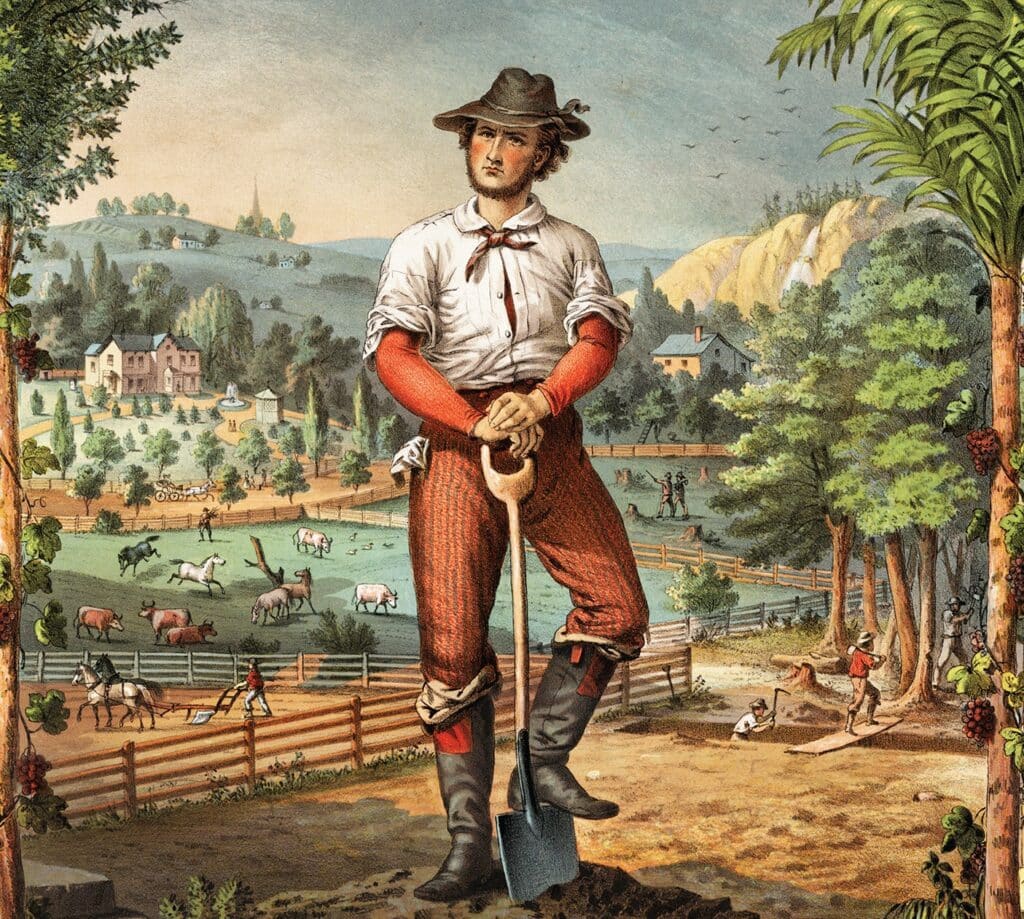The legend of Johnny Appleseed as an American pioneer nurseryman who introduced apple trees to the Midwest and beyond is a uniquely American story that to this day continues to be shared with school-age children, who take away lessons of a simple life and living close to nature, and a greater appreciation for the important role apples play in our history and daily diet.
Johnny Appleseed was actually based on a real person, John Chapman. Born in Massachusetts in 1774, Chapman started collecting apple seeds from cider presses in western Pennsylvania in his early 20s, and then spent most of the first half of the 19th century traveling on foot across the Midwest with missionary zeal, selling or giving away apple seedlings to primarily pioneers for planting apple orchards. His unconventional ways and manner of dress gave birth to plenty of tall tales that eventually found their way into American folklore.
“Johnny Appleseed” made his first major appearance in 1871, decades after Chapman’s death in 1845, in an article by W.D. Haley that appeared in Harper’s Monthly. Haley was an abolitionist-turned-family farm crusader for the Patrons of Husbandry, also known as the Grange movement. Despite the folkloric characterization of Johnny Appleseed as “a kind of magical Santa Claus responsible for almost all the apple trees planted across Ohio,” the true story of John Chapman was quite different.
According to Chapman’s Fort Wayne Sentinel obituary, Chapman was a footloose nurseryman and promoter of apples, who was “well known through this region by his eccentricity and singular garb.” That included, like the caricature that has survived to modern day, a “coarse coffee sack” full of apple seeds with a hole for his neck and the waists of four pairs of pants “shingled” ’round him. A 2011 biography argued that Chapman should be considered insane by our standards.
The apples that Chapman brought to the frontier were completely distinct from the apples available at any grocery store or farmers’ market today, and they weren’t primarily used for eating—they were used to make America’s beverage-of-choice at the time, hard apple cider.
“Up until Prohibition, an apple grown in America was far less likely to be eaten than to wind up in a barrel of cider,” writes Michael Pollan in The Botany of Desire. “In rural areas cider took the place of not only wine and beer but of coffee and tea, juice, and even water.” Transplanted New Englanders on the frontier drank a reported 10.52 ounces of hard cider per day (for comparison, the average American today drinks 20 ounces of water a day), writes Howard Means, author of Johnny Appleseed: The Man, the Myth, the American Story. “Hard cider was as much a part of the dining table as meat or bread.”
Chapman was not the only person to spread seeds around to introduce new crops not indigenous to North America. Thomas Jefferson was an amateur gardener with an unrelenting enthusiasm for natural history and horticulture, once writing “the greatest service which can be rendered any country is to add an useful plant to its culture.” Jefferson strove to make his plantation at Monticello an experimental station of new and unusual plants that he hoped could advance the social and economic culture of the young United States. For example, Jefferson smuggled a dry-land variety of rice out of Italy in his coat pockets with the aspiration of moving Lowcountry Carolina rice growers and their enslaved African Americans away from malarial swamps to higher, healthier Piedmont lands. After a tour of northern New York and New England in 1791, Jefferson was inspired to plant sixty sugar maple trees at Monticello, writing that the culture of sugar cane in the deep South, and its reliance on slave labor, could be replaced in central Virginia with the growing of maple trees requiring only “the labour of children.” Unfortunately, none of these experiments succeeded. His greater success came as a facilitator. Jefferson encouraged early viticultural pioneers to develop an American wine industry, distributed sesame seeds to other progressive farmers for domestic oil production, and choreographed the propagation and distribution of the promising native American crops and indigenous western species brought back by the Lewis and Clark Expedition.
Over the next century, seeds were imported, distributed, and planted across a west-ward bound country, first as a way to sustain pioneering families and later, with advances in agricultural production, as a way to turn farm crops into a profit. Farming was becoming a big business, especially with rail transportation making it easier to bring a harvest to market. Supporting, protecting, and advancing this new agribusiness economy was The National Grange of the Order of Patrons of Husbandry, or the Grange, founded after the Civil War in 1867 as a way to promote the social and economic needs of farmers in the United States. The first Grange, Grange #1, was founded in 1868 in Fredonia, New York.
While seeds lie at the root of our national and international food supply and agricultural economy, technology continues to be the game-changer when it comes to planting and harvesting, and the yield necessary to turn a profit. In this issue, we take a seed-to-harvest look at the history of agriculture in our country by learning more about the inventions of Cyrus McCormick (the mechanical reaper), John Deere (the motorized tractor), and Thomas Dugan (the rye cradle), the history behind heirloom seeds, the importance of the Farmer’s Almanac, and the economy behind canning. We also go to one of the farthest and coldest regions on earth to explore the mission and contents of the National Seed Vault, the world’s insurance policy to protect the crop seeds of our past for planting by future generations.





Related posts: